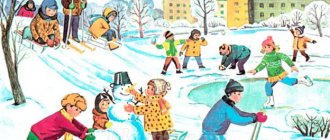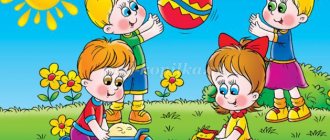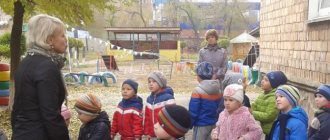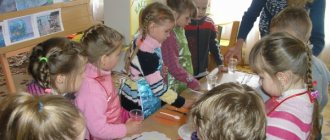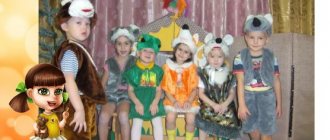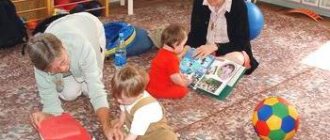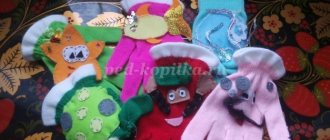Methodological aspects of work before bedtime in kindergarten
Sleep is an integral part of a child's daily routine. Particular attention is paid to the organization of daytime rest in kindergarten, since during periods of wakefulness children are usually very active, and it is very important for the baby’s body to restore strength and accumulate energy for activities in the afternoon. The teacher faces the difficult task of arranging bedtime so that all the children have the opportunity to rest.
Working with children before bed - goals and methods
Sleep is necessary to restore the baby's physiological and mental balance . According to sanitary and hygienic standards, its duration for children under 5 years old is 2 hours, for children under 7 years old - 1–1.5 hours.
Sleep is the basis of a child's health
In order for a child’s sleep to become a physiological habit, it is necessary to strictly follow the daily routine, down to every minute. Then, by the time the daytime rest begins, the child will be ready for it.
Many preschoolers have a thousand reasons not to fall asleep, so methodical work before daytime rest plays an important role. Its goals are:
To achieve his goals, the nap organizer faces a number of tasks that he has to solve every day:
The room where children sleep must be ventilated in advance.
Methodological organization of preparing children for bed
To achieve the assigned tasks, the teacher:
These techniques can be used in combination, but for children of the first and second junior groups, who due to age get tired faster, and therefore need rest more than others, it is enough to turn on background music after lunch (while carrying out hygiene procedures, changing clothes) and reading fairy tales. For children in the middle group we add breathing exercises. In addition to their beneficial effect on the respiratory system, they also help develop correct sound pronunciation. This is a very important task for this age. This gymnastics is carried out 20–30 minutes after lunch. Older children can play a little quiet games before starting hygiene procedures.
Many psychologists deny the importance of daytime sleep, since such a regime, strictly observed in kindergarten, suppresses the individuality of children who do not want to sleep.
How to create favorable conditions for falling asleep
It is very important in what environment babies fall asleep. Set up for sleep:
Pastel colors of the environment, cleanliness and fresh air are the key to sweet sleep for babies
Comprehensive thematic planning of educational work in the middle group
| Creating conditions for independent activity | A selection of illustrations “The World of Professions”, pictures depicting representatives of different professions, objects they need, attributes for role-playing games. | ||||
Working with parents:
exhibition of drawings “All works are good”
Deadlines:
1st week of February (from 01.02 to 05.02..2016)
Subject
: Wild and domestic animals.
Final event:
game - dramatization of "Teremok".
Tasks:
expand ideas about wild and domestic animals. Clarify the external signs and habits of wild and domestic animals. Formation of primary value ideas about animals as “little brothers” of humans. Expand children's ideas about the life of pets in the winter season. Teach children to distinguish the characteristic signs of domestic animals (appearance, habits, and also know about the benefits they bring to people and human care for them), based on these specific ideas, form the simplest generalization “pets” animals”, teach children to care for small pets (rabbits, chickens). Form a desire to take care of pets. Introduce children to the life of wild animals in the forest in winter. To develop the ability to identify and characterize the features of the external appearance of animals and their way of life. Lay the foundations of environmental education. To cultivate a caring attitude towards nature, a sense of kindness, belonging and empathy for all living and beautiful things that surround us.
| Educational areas | Cognitive development | Social and communicative development | Artistic and aesthetic | Physical development | Speech development |
| Activities | Cognitive and research activities: b conversations: “Winter in the forest”, “How animals winter”; examination of demonstration material about winter in the forest; quiz “In the world of animals”; viewing photographs of domestic animals, images of domestic and wild animals, illustrations depicting animal characters; educational games “Whose house is this?”, “Who eats what?”, “Inhabitants of the forest”, “name the cubs”, etc.; animal observation Design: “Zoo”, “Forest kindergarten”, farm design. | Communication activities: d educational games: “Visiting Grandma Arina”, “What can animals do?”, Whose house is it?”, “Have animals settled in”, “Who lives where?”, “Who eats what?”, “Making and guessing riddles.” Self-care and basic household work: feasible tasks for caring for animals | Visual activities: drawing “Bunny”, applique “Striped rug for a cat”, modeling “Cat with kittens”, “Make whatever animal you want” Musical activities: hearing: "Bunny", music. Yu.Matveeva, lyrics by A.Blok. “The cat got sick”, “The cat got well”, music. A. Grechaninova. Singing: "Kitty", music. V. Vpitlina. Music game: “The Bear and the Hare”, music by V. Rebikov Reading fiction: "The Hare and the Hedgehog" from the fairy tales of the Brothers Grimm; “Fox - sister and wolf”, sampled by M. Bulatov; “Zimovye”, arr. I. Sokolova; "The Fox and the Goat", arr. O. Kapitsa; “Carrying Cow”, K. Ushinsky; "Little foxes." “Why was Tyupa nicknamed Tyupa” E. Charushin, V. Khorol “Goat” S, Marshak “Mustachioed and Striped”, “The Tale of a Stupid Mouse”, L. Kvitko “Kitsonka”, fairy tales by S. Mikhalkov “The Three Little Pigs”, Andersen “ The Ugly Duckling”, B. Grimm “The Town Musicians of Bremen”, E. Uspensky “Uncle Fyodor the Dog and the Cat”, R.N.S. "Dereza Goat", "Wolf and Seven Little Goats"; | Motor activity: outdoor games: “Greedy Cat”, “Homeless Hare”, “Wolf and Hares”, “Horses”, “Birds and Cats”, “Hunters and Hares”, “Hares and Bears”; simulation games characteristic features (habits, postures, movements) of animals; | Speech development: game exercise “Tell about the squirrel”; learning poems about animals; re-enactment of the fairy tale “The Wolf and the Little Goats” |
Stages of work before bed: time plan
There are 3 stages of organizing daytime sleep.
Preparation
The longest and most important stage. At the first stage, children play calm games.
Games for the first and second junior groups
Quiet games with objects:
Games for the middle group
Games for the middle group may include tasks for quick wits and ingenuity (but not only):
Mosaics and construction sets not only train coordination, develop the child’s thinking processes, but also perfectly relax
Games for senior and preparatory groups
These can also be motor games, after which you can tell a fairy tale or do breathing exercises:
It is advisable to involve all the children in the games.
Fairy tales
Children love fairy tales very much. And in younger groups, due to age-related slowness, there is no time left for games, so reading aloud is the best technique. Although older children will be happy to listen to the exciting story.
Poems
At the preparation stage, after playing and reading fairy tales, children go to the toilet and carry out hygiene procedures: they wash their hands, in the summer - their feet, and wash themselves. The younger ones do this with the help of a teacher and an assistant teacher. Adults accompany all actions with poems (especially important for children, whose actions are better organized by such rhymes); older children recite them together with their teachers.
Preparing for bed in the younger group begins with putting the kids on the potties
Hygiene is given special attention before bedtime
Game situation
It's time for the kids to undress, fold their things and put on their pajamas. The process of undressing can be turned into a game “We are already quite big.”
Creating game situations speeds up the process of undressing and dressing for bed
Alternatively, you can come up with a story about the Bella doll, which can’t remember in what order you need to take off your clothes: first the shoes, and then the dress, or vice versa? Many children, regardless of age, have difficulty keeping things in order. For such guys, you can use the story about Mitya, who after sleep was constantly dirty.
Relaxation
This stage is appropriate to carry out with calm music, which has a general calming effect. The best option is the sounds of nature (the noise of the forest, the murmur of a stream, etc.).
Breathing exercises
Before the kids go to bed, they are given 1-2 exercises (for the younger group), 2-3 for the middle, senior and preparatory groups.
"Rose and Dandelion"
"Breath"
Breathing exercises help children relax
Games with rewards
Reward games can be used to encourage sleep in older children.
Card index of games for artistic and aesthetic development in the middle group
Card index of games for artistic and aesthetic development in the middle group.
"Guess and Tell"
Target:
To consolidate children's knowledge about folk toys as one of the forms of folk arts and crafts; recognize a toy by its image, be able to explain your choice, highlight the elements of painting, its color and the composition of the pattern on the product. Develop aesthetic taste.
"Gorodets patterns"
Target:
To consolidate children’s ability to compose Gorodets patterns, recognize the elements of painting, remember the order of the pattern, choose their own color and shade for it, develop imagination, and the ability to use the acquired knowledge to compose a composition.
“Paint a scarf for mom”
Target:
To consolidate children's knowledge about the art of the Russian shawl. To develop children's aesthetic taste, to teach them how to make simple patterns from various decorative elements (flowers, leaves, buds, twigs, etc.), and the ability to select the color scheme of a pattern.
"Art Crafts"
Target:
To consolidate children's knowledge about folk arts and crafts; find the desired trade among others and justify your choice.
"Collect a Gzhel rose"
Target:
To consolidate children’s ability to compose a Gzhel rose using appliqué based on Gzhel painting, to maintain interest in Gzhel craft.
"Collect a matryoshka doll"
Target:
To consolidate children's knowledge about the folk toy - matryoshka; the ability to assemble a nesting doll from parts using the mosaic method. Highlight decoration elements. To cultivate respect and love for folk art.
“Complete the pattern”
Target:
The game is aimed at developing children's attention and memory, developing a sense of symmetry followed by coloring.
Progress of the game:
The beginning of the pattern is drawn on a piece of paper. Children need to extend the pattern further and color it.
"Find friends among the colors"
Target:
discover the level of children’s knowledge in choosing paint that matches the color of the object; draw in color
Progress of the game:
Silhouettes of objects are drawn on sheets of paper. The teacher gives the task to find “friends” of yellow, green, blue, and red colors among the objects. Children find objects that match a certain color and color them.
“Make a still life”
Target:
improve compositional skills, the ability to create a composition on a specific topic (still life), highlight the main thing, establish a connection by arranging the image in space.
Progress of the game:
The envelope contains images of various vegetables, fruits, as well as various vases, plates, dishes, and baskets. Children need to choose objects and create their own still life.
"Finish the picture"
Target:
discover the level of formation of perception and definition of an object behind its parts, be able to complete it; develop fantasy and imagination.
Progress of the game::
Objects are partially drawn in the pictures (bunny, Christmas tree.). You need to recognize the subject, fill in the parts that are missing, and color it.
“Let’s prepare the table for the holiday”
Target:
develop the ability to select shades of primary colors and create a beautiful color scheme.
Progress of the game:
In front of the children are cut out paper tablecloths of different colors (red, yellow, blue, green) and 4 - 5 shades of paper tableware of each color. The task is to match the main color to its shades. Select tableware so that the color matches the tablecloth.
Board game "Domino"
Target:
To consolidate children's knowledge about arts and crafts - toys; the ability to find the right toy and justify your choice. To consolidate knowledge about the manufacture of folk toys and the features of each. Cultivate a love of beauty.
“Paint a scarf for mom”
Target:
To consolidate children's knowledge about the art of the Russian shawl. To develop children's aesthetic taste, to teach them how to make simple patterns from various decorative elements (flowers, leaves, buds, twigs, etc.), and the ability to select the color scheme of a pattern.
"Art Crafts"
Target
: To consolidate children’s knowledge about folk arts and crafts; find the desired trade among others and justify your choice.
"Collect a Gzhel rose"
Target
: To consolidate children’s ability to compose a Gzhel rose using appliqué based on Gzhel painting, to maintain interest in Gzhel craft.
"Collect a matryoshka doll"
Target:
To consolidate children's knowledge about the folk toy - matryoshka; the ability to assemble a nesting doll from parts using the mosaic method. Highlight decoration elements. To cultivate respect and love for folk art.
“Complete the pattern”
Target:
The game is aimed at developing children's attention and memory, developing a sense of symmetry followed by coloring.
Progress of the game:
The beginning of the pattern is drawn on a piece of paper. Children need to extend the pattern further and color it.
“Find friends among the colors”
Target:
discover the level of children’s knowledge in choosing paint that matches the color of the object; draw in color
Progress of the game:
Silhouettes of objects are drawn on sheets of paper. The teacher gives the task to find “friends” of yellow, green, blue, and red colors among the objects. Children find objects that match a certain color and color them.
“Make a still life”
Target:
improve compositional skills, the ability to create a composition on a specific topic (still life), highlight the main thing, establish a connection by arranging the image in space.
Progress of the game:
The envelope contains images of various vegetables, fruits, as well as various vases, plates, dishes, and baskets. Children need to choose objects and create their own still life.
